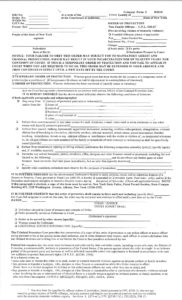Orders of Protection in New York Criminal Cases
An Order of Protection issued in a criminal case will prohibit a defendant from having contact with an alleged victim. Called a restraining order in other jurisdictions, an Order of Protection is an order from a judge. If not followed, this could subject a defendant to additional criminal charges.
What Does an Order of Protection Do?
An Order of Protection will mandate that a defendant refrain from certain contact with the victim of their offense. This may include any or all of the following:
- Stay away from the victim’s home, school, or business
- Avoid any communication with the victim, such as phone or e-mail
- Refrain from committing a new crime, such as stalking or harassment, against that victim
An Order may also require the defendant to surrender a pistol permit and/or any firearms. A judge could further impose any other condition that might be reasonably related to keeping the victim safe. The prosecutor must merely show “good cause” for issuance of an Order of Protection and the provisions therein.
Sample Order of Protection
How Are Orders of Protection Issued?
Orders of Protection are usually issued by a judge at an arraignment on new criminal charges. They are most often issued in cases where someone is injured, abused, or threatened. For example, if a defendant is alleged to have assaulted a victim, the judge will likely issue an Order of Protecting prohibiting the defendant from having any contact with the victim.
Orders of Protection can also be issued in family court. When there is a relationship between two people, such as a boyfriend-girlfriend situation or a marriage, one of the parties to the relationship can ask a family court to issue an Order. This can happen in conjunction with a criminal prosecution. But family court proceedings also need not involve the police or the District Attorney.
Can Orders of Protection Be Removed?
Temporary Orders of Protection only last for the pendency of the criminal case. If there is a conviction at the end of the criminal case, a Permanent Order may be issued. These last for certain periods of time as prescribed by law. In some cases, the Order may apply to a protected party for 10 years. If the case is dismissed, the Order will also be dismissed.
Sometimes, particularly in domestic situations, the victim may wish to communicate with the defendant while the case is pending or thereafter. A victim can ask the judge to remove the “stay away” provision from the Order of Protection. Or a judge can allow the victim and defendant to communicate via phone or email, or see each other at counseling sessions.
If an Order is violated, the defendant may be facing additional criminal charges. This includes a charge of Criminal Contempt as a misdemeanor or, in some cases, as a felony punishable by state prison.

